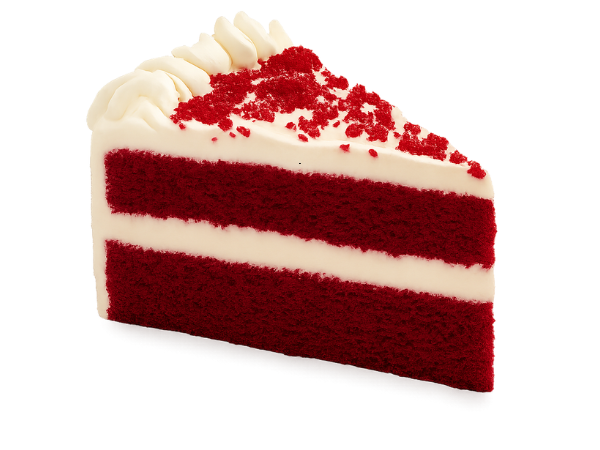
Red Velvet Cake
Caffeine
0–3 mg
Note: Caffeine amounts are based on a standard Red Velvet Cake recipe, which uses only a small amount of cocoa powder. Actual caffeine levels may vary depending on the recipe, portion size, and whether additional ingredients like chocolate, coffee, or matcha are added.
| Attribute | Value |
|---|---|
| Caffeine Level | Very Low |
| Serving Size (slice) | 100 g |
| Caffeine | 0–3 mg |
| Caffeine per 100 g | 0–3 mg |
| Calories | 360–370 kcal |
| Sugar | 17 g |
Red Velvet Cake is a classic dessert known for its striking red color, moist texture, and subtle cocoa flavor. While it is not typically thought of as a source of caffeine, the small amount of cocoa powder used in its recipe does contribute trace levels.
What Is Red Velvet Cake?
Red Velvet Cake is a layered dessert that combines a mild cocoa flavor with a tangy cream cheese frosting. Its signature red hue comes from food coloring or natural alternatives like beet juice.
Defining traits of Red Velvet Cake include:
- Color: Distinctive red or reddish-brown crumb.
- Flavor: Mild cocoa taste balanced with vanilla and tangy buttermilk.
- Texture: Soft, moist, and tender crumb.
- Frosting: Traditionally paired with cream cheese frosting.
- Occasions: Popular for birthdays, weddings, and holidays.
This cake is beloved not only for its flavor but also for its visual appeal, making it a centerpiece dessert at celebrations.
Nutritional Facts of Red Velvet Cake
Red Velvet Cake is calorie-dense, like most frosted cakes, due to its sugar, butter, and cream cheese frosting. A standard slice provides a significant portion of daily energy intake.
Average nutrition per 100 g of Red Velvet Cake:
- Calories: 367 kcal
- Protein: 6.8 g
- Fat: 17 g (with 5 g saturated fat)
- Carbohydrates: 47 g
- Sugars: 17 g
- Fiber: 1.4 g
- Sodium: 311 mg
While indulgent, Red Velvet Cake does provide some protein and minerals, though its high sugar and fat content mean it should be enjoyed in moderation.
Red Velvet Cake Ingredients and Cocoa Content
The ingredients of Red Velvet Cake are similar to other sponge cakes but with the addition of cocoa powder and red coloring. The cocoa is what introduces trace caffeine.
Common ingredients include:
- Flour and Sugar – The base structure and sweetness.
- Eggs and Butter – Provide richness and texture.
- Buttermilk – Adds tanginess and moisture.
- Cocoa Powder – Small amount for flavor and color depth.
- Red Coloring – Traditionally food dye, sometimes beet juice.
- Cream Cheese Frosting – A signature topping.
Because the cocoa content is minimal (usually 1–2 tablespoons per cake), the caffeine contribution is very low compared to chocolate desserts.
How Much Caffeine Is in a Slice of Red Velvet Cake?
A typical slice of Red Velvet Cake contains little to no caffeine, since the cocoa powder used is minimal.
Caffeine per slice (~100–110 g):
- Plain Red Velvet Cake: 0–3 mg
- Chocolate-Enhanced Versions: 5–10 mg
- Comparison: A cup of coffee has 95 mg caffeine.
This means that even caffeine-sensitive individuals can usually enjoy a slice without concern, though recipes with extra cocoa or chocolate may contain slightly more.
Caffeine Content per 100g of Red Velvet Cake
When measured by weight, Red Velvet Cake remains very low in caffeine compared to beverages or chocolate desserts.
Caffeine per 100 g serving:
- Standard Red Velvet Cake: 0–3 mg
- Chocolate-Heavy Variations: 5–10 mg
- Matcha or Coffee-Infused Versions: 15–30 mg
This shows that unless additional caffeinated ingredients are added, Red Velvet Cake is essentially caffeine-free for most practical purposes.
Do Variations of Red Velvet Cake Contain More Caffeine?
Yes — variations that include more cocoa, chocolate chips, or even coffee can increase the caffeine content. While still low compared to drinks, these versions may matter for those avoiding caffeine.
Caffeine-containing variations include:
- Chocolate Red Velvet Cake – Extra cocoa or melted chocolate increases caffeine.
- Mocha Red Velvet Cake – Coffee or espresso powder adds noticeable caffeine.
- Matcha Red Velvet Cake – Green tea powder contributes higher caffeine levels.
- Cupcakes and Minis – Same recipe, but caffeine per piece depends on portion size.
These variations remain indulgent desserts, but their caffeine levels can range from negligible to similar to a small cup of tea.
